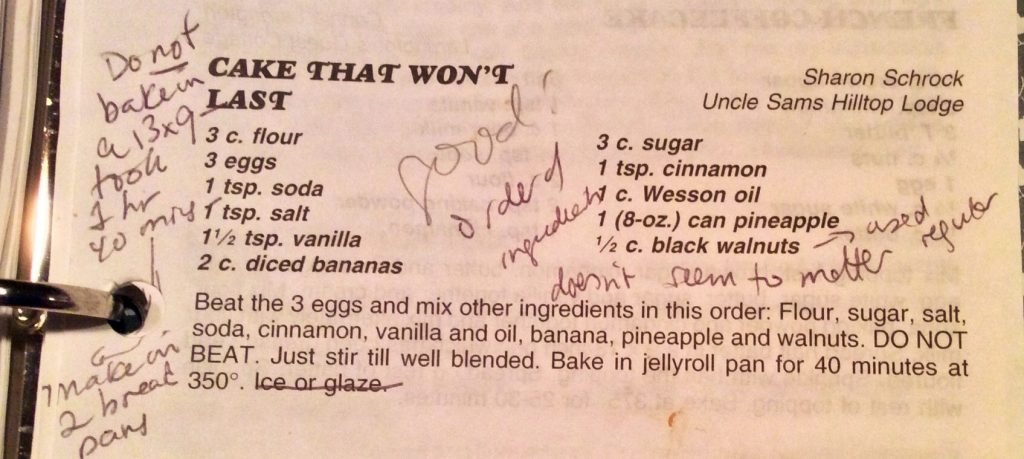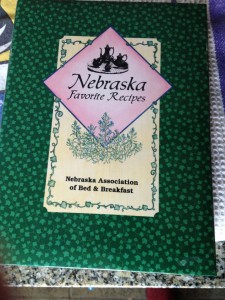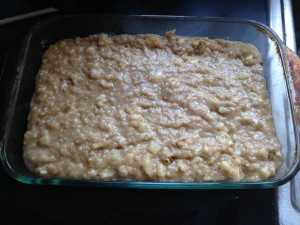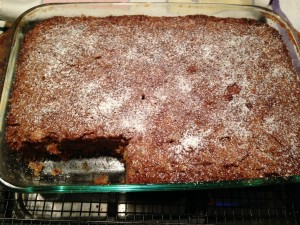By Katja
We’ve served the “cake that won’t last” many times, but we’ve never actually called it by its name on the breakfast board. We don’t want to brag, nor be secretive about its ingredients: after all, if people don’t know what they’re eating, they might not eat it, which in turn means it’ll be a cake that will last. We want this cake to remain a Towne Motel favorite and live up to its name – even if that name remains a secret (for anyone other than readers of this blog).
So we usually call it banana pineapple walnut bread, or pineapple banana cake with walnuts, which is pretty much what the major flavors are. Besides sugar, of course. But sugar isn’t really a flavor, is it? And baked goods aren’t always named after their main ingredients; otherwise most would have names like, “sugar egg cake with butter and flour,” or “buttery pound cake with beaten eggs,” or maybe just BSFE cake. I guess the word “cake” or “cookies” implies these standard ingredients, just like the word “candy” implies sugar. Which raises the question, how did sugar cookies get their name? Do they have more sugar than other cookies? Is sugar the only flavor they have?
But I digress. The recipe for this banana pineapple walnut bread comes from a spiral bound Nebraska cookbook, acquired while we lived and taught there (and where we did a lot less baking than we do here). I bought it in Wayne, Nebraska, at the local B&B called Grandma Butch’s, where I stayed while looking for housing in town. (The inn closed soon thereafter, I can’t remember why. I’m pretty confident it wasn’t my fault).. A lot of recipes in the notebook sound old-fashioned – or maybe just traditionally Midwestern: Jello salads, applesauce bread, chicken and dressing casserole. A baked corn casserole with five ingredients: spaghetti, chopped onion, creamed canned corn, whole canned corn, and Velveeta. (!) “Easy Cornbread” made of equal parts Jiffy cornbread mix and Jiffy yellow cake mix. And these are all inn recipes! Homebaked, but with processed ingredients. Sort of from scratch, but not really. Most B&Bs wouldn’t be able to get away with that now, at least not in our neck of the woods…
Minimalist Recipes
The “cake that won’t last” is one of those minimalist recipes that don’t give you much information other than the list of ingredients, followed by directions that seem to have skipped a few steps. Something like, “Put in large loaf pan. Bake at 350 degrees for 45 minutes to an hour.” (The latter is part of a pound cake recipe from the same cookbook. I made it; it’s great. I guess if you’ve made other pound cakes, you really don’t need more than the list of ingredients)
It would be hard to find such cut-to- the-chase recipes on popular food and baking blogs, but if you have any old cookbooks or handwritten recipes inherited from previous generations, you will know what I mean. (Online, I’ve primarily found them on cooks.com, a good no-frills recipe site) Short, to the point recipes were probably all written by housewives for housewives, most of whom could think of more exciting things to talk about than cake and casserole recipes. Women who expected their audience to know how and in which order to handle ingredients. And women who would never idealize or even fetishize baking and cooking, because it wasn’t their passion – it was their job.
My mom sends me yeast bread recipes in the minimalist category: a list of ingredients, followed by the direction, “make a yeast dough.” Nothing about the rise times and order of ingredients. Sometimes the amounts are ballpark figures (3 1/2 – 4 cups of flour), or simply a bit vague: “lemon,” it would say, or “salt” or “vanilla.” I’m expected to know the specifics, since, after all, she’s been telling me these things ever since she taught me about baking. If you make something often enough, my mom says, you make it according to “Gefuehl und Wellenschlag,”– a German expression that doesn’t make much sense once you think about it or try to translate it: “feeling and wave pounding.” Basically, it means you play it by ear and go by instinct and experience. No idea how this expression came about.
Cake that Won’t Last – The Recipe
The recipe for our banana pineapple walnut “cake that won’t last” is a bit more detailed than other minimalist recipes, but not very helpfully so. You start by beating 3 eggs, and then mixing in – in this order, supposedly – 3 cups flour, 3 cups sugar, 1 tsp. salt, 1 tsp. baking soda, 1 tsp. cinnamon, 1 ½ tsp. vanilla – followed by 1 cup oil (not clear what kind), 2 cups diced banana, one 8 oz can pineapple (I assume crushed, but that’s not clear, nor is it clear whether it should be drained or not. I drain it), and ½ cup chopped black walnuts (regular walnuts are fine).

If you’ve ever tried to add 6 cups of dry stuff to 3 beaten eggs, you probably know that at best, you’ll end up with dry, sandy streusel. So I begin to mix in the wet stuff earlier, which is still a bit of a struggle because you’re supposed to do it by hand. I remind myself that I’ve made this before and it always works out, so I just keep going until it all becomes one wet, unified mess. So, if you like the feeling of seeing something work out that seemed at first impossible, this is the cake for you! It actually feels less and less impossible the more often you make it. And you’ll probably make it often – unless you’re not a baker, of course.
I always use a 9 by 13 baking pan for this cake, but loaf pans would probably work just as well, as long as you adjust the baking time (how, I’m not sure, but I’m sure Google can figure it out). The temp is the usual: 350 degrees. We have a note next to the recipe, from the one time Siobhan tried her hand at it: “Do NOT bake in a 9×13 pan; it took one hour and 40 minutes.” I’d take that advice with a double tablespoon of salt – that never happened to me. Maybe she got punished somehow for making one of my recipes? The directions say 40 minutes (in a jelly roll pan – which we never use, and probably don’t own), and, as far as I know, it doesn’t take any more than 60. But I just use the eyeball and cake tester method, so I don’t remember the exact time. My note next to the recipe says: “Good! Order of ingredients doesn’t seem to matter.”
There is something pretty great about one-paragraph recipes. Sure, they can be confusing for anyone who doesn’t know what they’re doing: no step by step photo instructions or fool proof explanations. No stooping down to “visual learners”: there are usually no photos at all, much less photo tutorials of how to beat egg whites or pour sugar into a bowl. But I like the fact that minimalist recipes aren’t self-absorbed and self-indulgent. Unlike most baking blog recipes, they don’t try to promote a whole website and persona along with the recipe. They don’t tell you about the author’s dog and husband and pre-blog career, much less her new kitchen gadgets or the stages of her pregnancy. They don’t come with an entourage of pop-up ads or corporate endorsements (unless they’re in a Kraft or Pillsbury cookbook, of course), and they don’t shower you with ten shiny photos of the final product barely distinguishable from each other. The little you see is what you get: a list of ingredients, and basic instructions.
Chatty Baking Blog Recipes
That said, chatty recipe blog posts have some personality and can be more fun to read, as long as they aren’t cluttered by newsletter invites and reminders from the last websites you shopped on (and they almost always are). Their authors are almost all female, usually in their thirties, and their blog personas tend to be enthusiastic, humorous, and full of creative and business energy. Many of them celebrate baking, writing, family, and the blogger’s pets, house, kitchen, garden, and local markets. Most of all, they make public what used to be mostly private and domestic: the collective traditional housewife experience, when women shared handwritten recipes, cooked and baked, and fed the results to neighbors, friends and family. These used to be everyday activities in most women’s lives; but they weren’t publicly discussed or valued, and most certainly didn’t get paid or written about. Some baking bloggers are new mothers or mothers to be, having quit their jobs at least temporarily to be with the kid(s). Blogging allows them to turn their creative passions and new home lives into something more public and fulfilling.
Successful baking blogs often create a fantasy of a busy and productive, yet largely stress-free, fulfilling home life celebrating women’s traditional creative work and community. But a successful baking blog is only partly about nostalgia; it’s almost an ideal marriage of past and present, and that might be its main appeal for female readers. Food bloggers spend a lot of time in the kitchen, and much of their daily lives resemble that of a traditional stay at home mom. But they’re not ignored, alone, and working for free, and they take on a host of other identities as well: entrepreneur, writer, chef, photographer, teacher, webmaster – perhaps even a minor Internet sensation or soon to be cookbook author. They might see themselves as food artists, designers, and architects, multi media style – creating food, documenting their creations in words and images, photographing, facebooking, instagramming, and pinning them.
Food blogging also involves storytelling; at least two different kinds, with the recipe at the center of both.
There is written storytelling: stories and anecdotes about the recipe’s origin, what it means to its author, why it got to be on her blog, how she tweaked it to make it even better, and how it has performed at parties and holiday meals.
There is also visual storytelling – the photo story of the recipe instructions, starting with a mouthwatering shot of the final product in its glory, and followed by step by step visuals how to get there. (A bit like a movie that starts with the ending, and then goes back to the beginning with something like “Ten years earlier”). The suspense, such as there is, is about the how rather than the what. The story pretty much follows the traditional linear narrative structure: exposition, rising action, climax, falling action, and conclusion.
In drama and fiction, the exposition introduces at least parts of the setting and characters; in recipe photo stories, the setting is always a kitchen; and the “characters” are primarily the ingredients, secondarily the tools – often introduced together, as if in a group portrait.
Next is the rising action, when the “characters” are beginning to do things or having things happen to them. In the case of a pound cake, let’s say, the butter is usually the first to come on stage: relaxing and softening in the microwave, it gets ready to gyrate with the sugar in a stand mixer (almost always Kitchenaid). Then the eggs come (or are forced?) out of their shells and start mingling, one by one, with the spiraling mass on the (Kitchenaid) dance floor. Meanwhile, in another part of the kitchen, the flour and other dry ingredients get ready together before joining the rest of the party. Once everyone (including any late arrivals, such as sour cream, fruit, nuts, chocolate chips, etc) has thoroughly mingled into a batter, we get to admire its shape in a baking pan, waiting to go into the oven.
A modicum of suspense might kick in at this point – at least for anyone who forgot what the final product looks like – to be followed by the climax(es): photos of the finished product. From any angle, fresh out of the oven, released from the baking pan, glazed, iced or dusted with powdered sugar, maybe even served to someone, with tea or coffee, flowers and napkins. Some photo stories end with a half eaten piece of cake, which could qualify as the “falling action,” (almost literally so), and /or some wrap up comments by the author – the resolution or conclusion.
As you can tell, these photo stories don’t have a very exciting plot. Characters don’t overcome obstacles or go through conflicts or set off on journeys to end up somewhere you never predicted. Not that baking can’t be adventurous: ingredients and tools can act unpredictably, bakers can fall asleep while their cakes are burning and shriveling in the oven (I’m speaking from experience); baking pans can refuse to release their contents, and dogs can demolish any masterpiece in a matter of seconds. Baking blog stories are different: you know that everything will turn out well. There may be some challenges along the way, like tricky timing or decorating, but in the end, ingredients are happily united, baked to perfection, and memorialized by a series of perfect photographs.
Clearly but hopefully not unfortunately, this post turned out very differently from what I had planned. I was just going to give you the recipe for our “cake that won’t last,” add some comments, and be done with it. But then I wandered off into comparisons between old-fashioned minimalist recipes and the chatty blog recipes I’ve come across in the past few years, baking for guests. And in the process this one became a very chatty post itself: more than three pages of discussion and digressions about a one paragraph recipe! Which reminds me of my ex-students, who often wondered how anyone can assign, much less write, a 3-5 page paper on a one-stanza poem. Dear reader, forgive me – it seems you can take a teacher out of academia, but a part of academia will always remain in the teacher. Which means, of course, that this lesson concludes with some homework:
Make the cake! It’s easy, it’s good, and you can call it whatever the heck you want. You won’t even get graded – except by the people you feed it to, and they will probably give you an A :).




